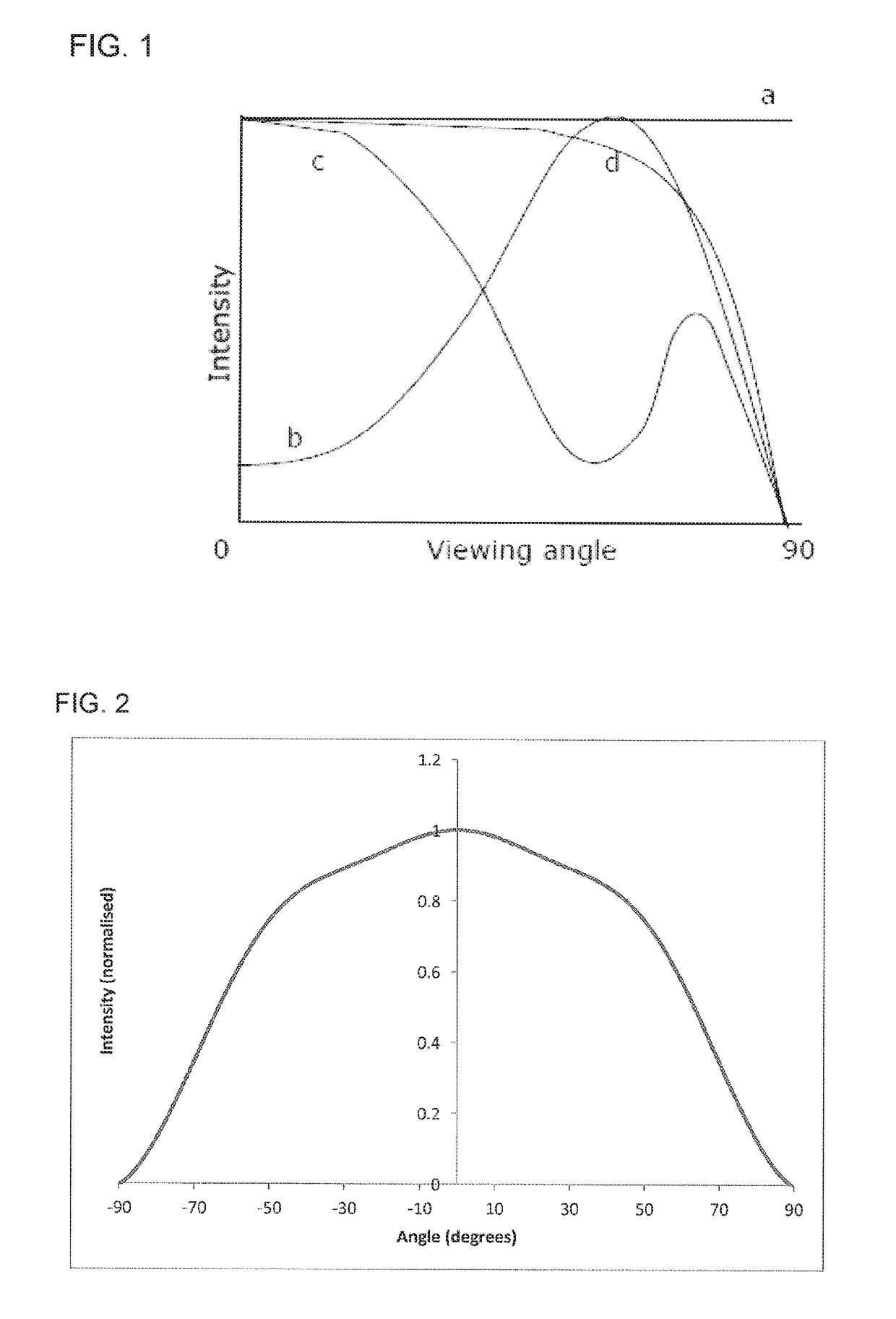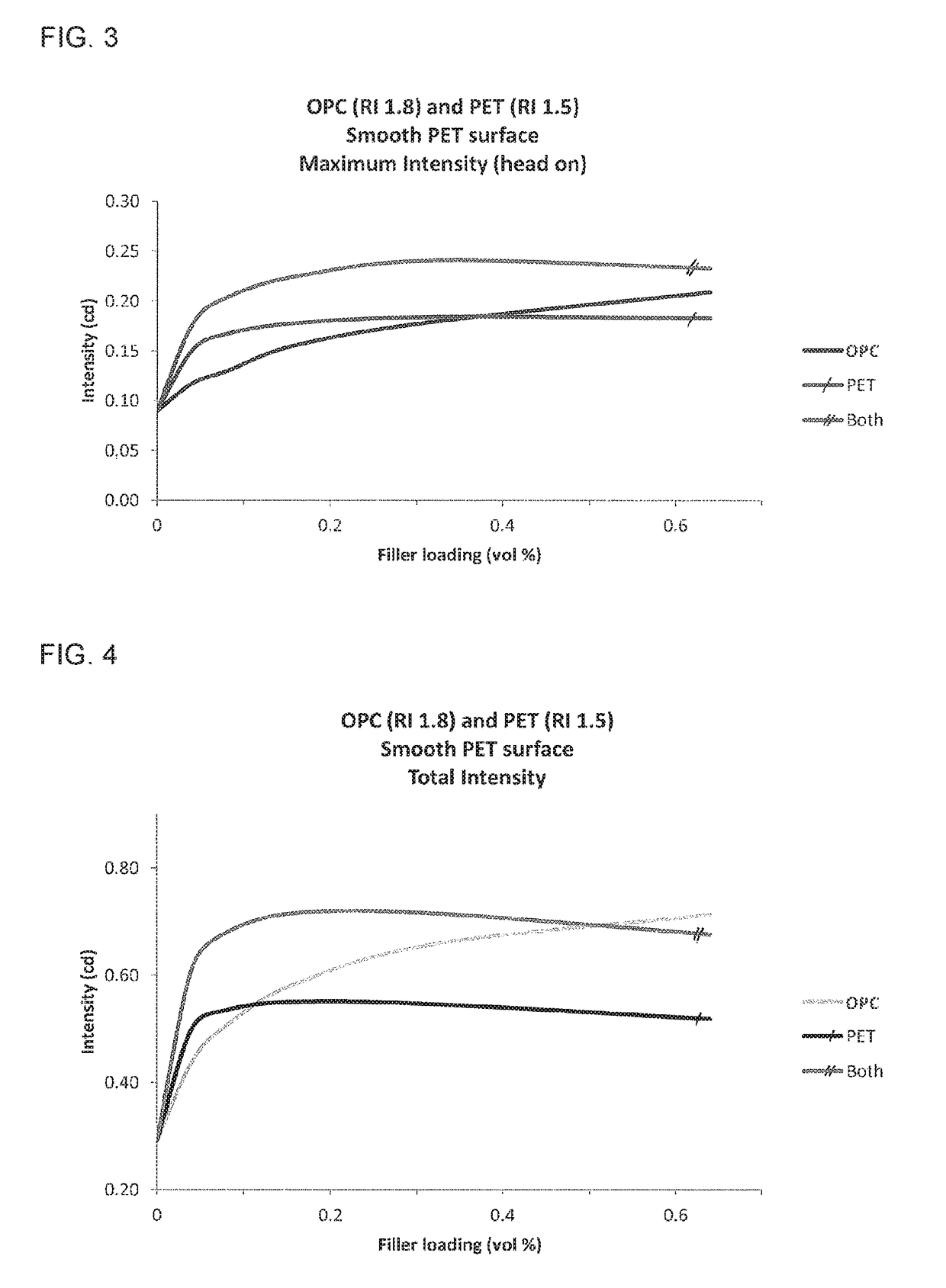Organic light-emitting diode light source comprising a polyester film and a method of improving light extraction from said light source
a light source and organic light-emitting diode technology, which is applied in the direction of organic semiconductor devices, sustainable manufacturing/processing, final product manufacturing, etc., can solve the problems of affecting the light extraction efficiency of a planar oled design containing multiple thin organic and inorganic films, and the absorption loss becomes more significant, so as to increase the external extraction efficiency of an oled light source, increase the power, efficiency, lifetime and brightness of the device, and increase the external extraction efficiency of an o
- Summary
- Abstract
- Description
- Claims
- Application Information
AI Technical Summary
Benefits of technology
Problems solved by technology
Method used
Image
Examples
example 1
[0248]The extraction efficiency of a first series of bottom-emitting OLED light sources was tested. Each OLED in the series used the same multi-layer light-emitting assembly, and the light profile emitted from that assembly is represented in FIG. 2.
[0249]The polyester film substrate in each OLED was a biaxially oriented PET film of thickness 100 μm comprising varying concentrations of TiO2 light-scattering particles (P1). The TiO2 particles had a particle size 200 nm and were in the rutile crystal form, and substantially spherical in shape. The TiO2 is introduced into the polyester film substrate during extrusion in the form of a concentrated masterbatch of inorganic TiO2 particles dispersed in polyester. The refractive index in the thickness direction of the filmed PET measured as described herein was approximately 1.5.
[0250]The organic planarising coating layer (OPC2) in each OLED was a cured cross-linked acrylate resin composition and had a dry thickness of 20 μm. The organic pla...
example 2
[0257]The extraction efficiency of a second series of bottom-emitting OLED light sources was tested. The OLEDs corresponded to those of Example 1, except that the internal surface of the polyester film substrate was roughened using the abrasive blasting technique described herein to produce a surface which exhibited roughness values Ra of 770 nm and Rq of 1140 nm and a haze of 90% (measured on the free-standing film in isolation and prior to application of the internal layers of the OLED described herein).
[0258]FIGS. 5 and 6 show the maximum and total light output efficiencies, respectively.
[0259]The data in FIG. 5 confirm the conclusion from FIG. 3, namely that the combination of the internal and external extraction structures has the effect of increasing the maximum light output from the OLED, relative to the light output of OLEDs with only one of either extraction structure.
[0260]A comparison of FIGS. 3 and 5 shows that the increased roughness of the internal surface of the polye...
example 3
[0262]This Example modifies Examples 1 and 2 by changing the refractive index of the polyester film substrate to 1.65. Increasing the RI of PET from 1.5 to 1.65 requires 10 wt % of non-light-scattering TiO2 particles (RI 2.874; size less than 60 nm). In this way, a third and fourth series of OLED light sources are generated, one with a smooth internal surface of the polyester film substrate and one with an abrasion-blasted internal surface. The maximum and total light output efficiencies for each series are shown in FIGS. 7 to 10. The results are consistent with the conclusions from the first and second series.
[0263]The light emission profile (i.e. the angular dependence) of OLED light sources comprising light-scattering particles in an amount of 0.16 vol % in each of the polyester film substrate and / or the organic planarising layer (OPC2) was compared against control OLEDs comprising no light-scattering particles in these layers. The results are shown in FIG. 11. FIG. 12 presents t...
PUM
 Login to View More
Login to View More Abstract
Description
Claims
Application Information
 Login to View More
Login to View More - R&D
- Intellectual Property
- Life Sciences
- Materials
- Tech Scout
- Unparalleled Data Quality
- Higher Quality Content
- 60% Fewer Hallucinations
Browse by: Latest US Patents, China's latest patents, Technical Efficacy Thesaurus, Application Domain, Technology Topic, Popular Technical Reports.
© 2025 PatSnap. All rights reserved.Legal|Privacy policy|Modern Slavery Act Transparency Statement|Sitemap|About US| Contact US: help@patsnap.com



